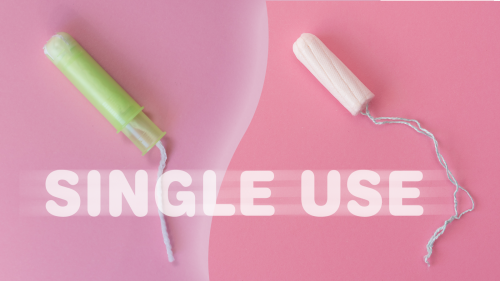What You Need to Know About Tampons
The Facts on Tampons—and How to Use Them Safely
Tampons cleared past the FDA are meant to be used once and then thrown away. No tampon should be used more once.
Image

Explanation
Español
If you use tampons during your period (or menstruum), it'south important to know how to use them safely. Consider this important information from the U.South. Food and Drug Administration (FDA)—and please share this information with other people who may use these products.
What are tampons—and how are they used?
Tampons are one method of absorbing menstrual flow during your period. Tampons are designed to be inserted into the vagina with or without an applicator.
You may exist surprised to learn that the FDA regulates tampons equally medical devices. Tampons cleared past the FDA are meant to be used once and then thrown away. No tampon should be used more than once.
What are tampons made out of?
FDA-cleared tampons are made of cotton wool, rayon, or a blend of the 2. The absorptive fibers used in FDA-cleared tampons sold today are made with a bleaching process that is free from elemental chlorine, which besides prevents products from having dangerous levels of dioxin (a type of pollutant found in the environment).
How does FDA evaluate the safety of tampons?
Earlier whatsoever tampons tin can be legally sold in the U.S., they must get through the FDA's review to determine whether they are equally safe and effective as (substantially equivalent to) legally marketed tampons.
As function of the FDA's review, manufacturers submit data including the results of testing to evaluate the safety of the materials used to make tampons and applicators (if present); tampon absorbency, strength, and integrity; and whether tampons enhance the growth of certain harmful leaner or change normal leaner levels in the vagina.
Are reusable tampons rubber?
Reusable tampons may carry additional risks of infections such as yeast, fungal, and bacterial infections.
While you may have heard near reusable tampons, the FDA has not cleared or canonical these products. The FDA discourages the use of reusable tampons.
The only tampons cleared or canonical by the FDA are designed for single-use.
What should you lot know about tampons and toxic shock syndrome (TSS)?
Toxic daze syndrome (TSS) is rare and is caused by a toxic substance that is produced past sure kinds of bacteria. The toxic substance produced by the bacteria can cause organ impairment (including kidney, eye, and liver failure), shock, and even death.
Rates of reported TSS cases associated with tampons have declined significantly over the years. One reason is that the FDA evaluates whether a tampon enhances the growth of the bacteria that causes TSS earlier the production can be legally marketed. Merely tampons that have been cleared by the FDA can be legally marketed in the U.S. In improver, more informative tampon labeling, equally well as educational efforts by the FDA and manufacturers, may take contributed to the reduction in TSS cases. For more data on TSS, run into the tampon safety tips, beneath.
Tampon Rubber Tips
Y'all may want to talk with your wellness care provider about whether tampons are right for you. If y'all utilize tampons, consider the following:
- Follow all labeled directions. Even if you have used tampons before, read the instructions in the package.
- Wash your hands before and after using a tampon. This volition aid reduce the spread of bacteria.
- Only use tampons when you take your period. Tampons are not intended to be used at any other time or for any other reason.
- Change each tampon every iv to 8 hours. Never wear a single tampon for more than eight hours at a time.
- Employ the everyman absorbency tampon needed. If you can wearable i tampon up to eight hours without irresolute information technology, the absorbency may be too loftier.
- Contact your health care provider if you lot have pain, fever or other unusual symptoms. If y'all take discomfort, pain or other unexpected symptoms like unusual discharge when trying to insert or habiliment a tampon, or if you accept an allergic reaction, stop using tampons and contact your provider.
- Know the signs of toxic shock syndrome (TSS) and how to reduce your risk. Symptoms and signs of TSS may include a sudden fever (usually 102°F or more), vomiting, diarrhea, fainting or feeling like yous are going to faint when standing upward, dizziness, or a rash that looks similar a sunburn. If y'all have whatsoever of these symptoms during your flow or soon after your period, finish using tampons and seek medical attention immediately. To reduce your hazard of TSS, use the lowest absorbency tampon necessary, habiliment a tampon for no more than than eight hours and and so throw it away, and apply tampons just when you have your period.
If you accept had discomfort or became ill as a result of using a tampon, consider reporting it to MedWatch, the FDA's safety information and adverse consequence reporting program. Data reported to MedWatch helps the FDA to ensure tampons remain safe and effective.
What You Need to Know About Tampons
Source: https://www.fda.gov/consumers/consumer-updates/facts-tampons-and-how-use-them-safely#:~:text=Tampons%20are%20one%20method%20of,time%20and%20then%20thrown%20away.
Post a Comment for "What You Need to Know About Tampons"